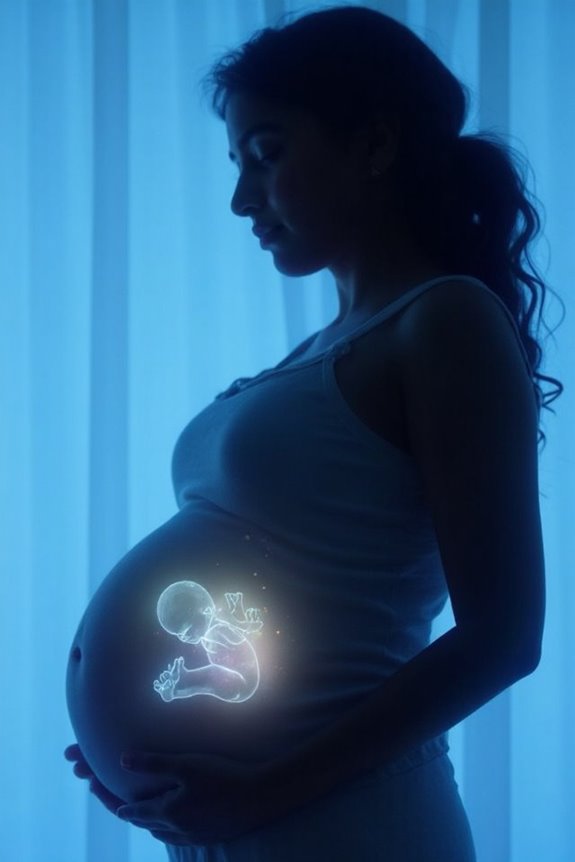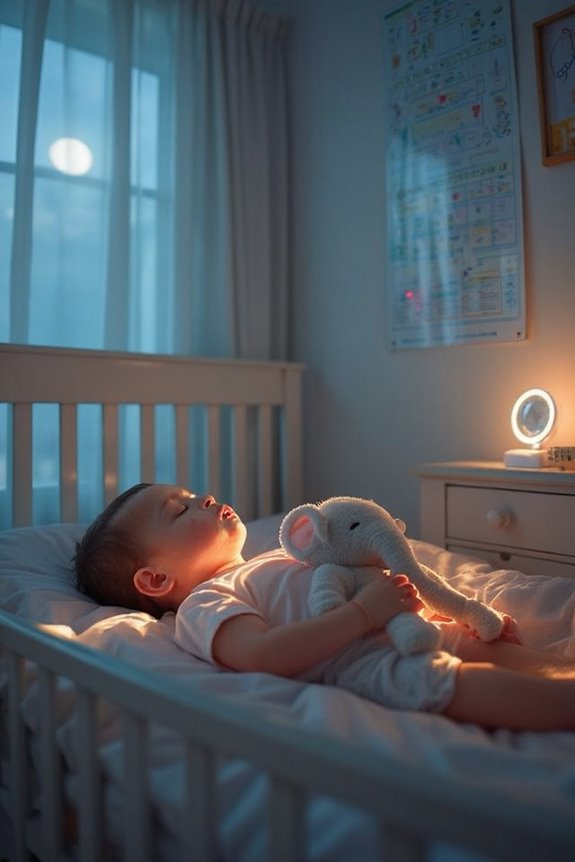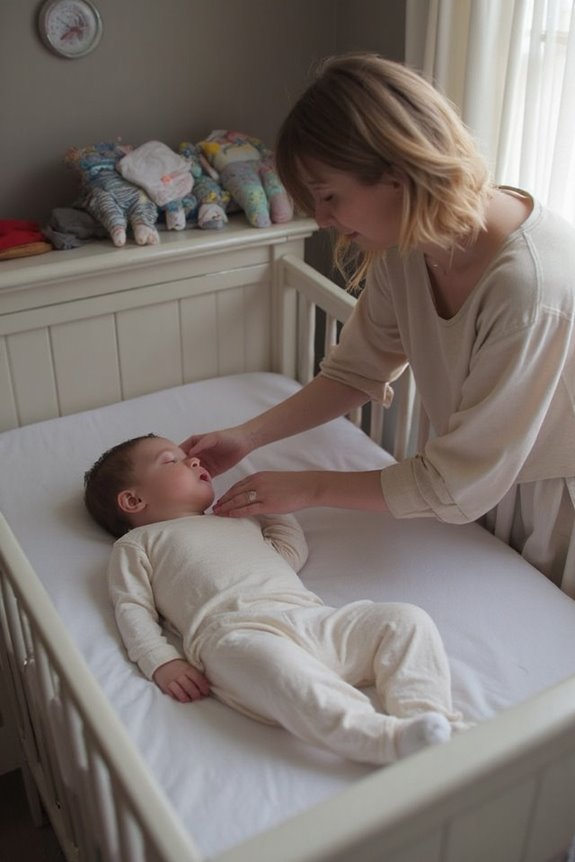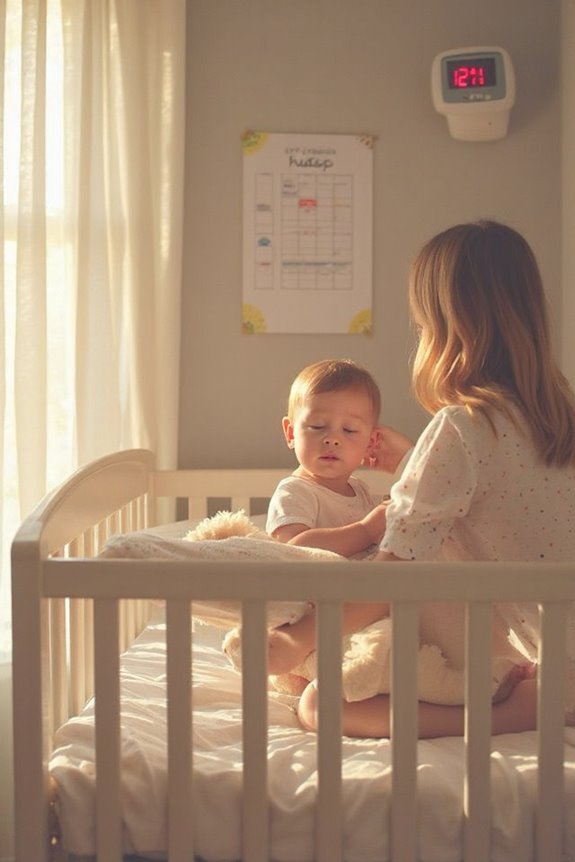Yes, babies definitely sleep in the womb. By 7 months gestation, fetuses spend about 95% of their time sleeping, alternating between REM and non-REM sleep cycles every 20-40 minutes. These sleep patterns begin developing in early pregnancy and become more structured in the third trimester. Fetal sleep plays an essential role in brain development, helping establish neural networks. Your baby’s sleep states can even be influenced by external factors like loud noises and your own sleep position.
Key Takeaways
- Babies develop sleep patterns before birth, cycling between REM and non-REM sleep every 20-40 minutes.
- By 7 months gestation, fetuses spend approximately 95% of their time in sleep-like states.
- Sleep cycles are shorter in early development, fluctuating every 5-10 minutes.
- Distinct sleep-wake cycles become fully established during the third trimester.
- Fetal sleep patterns contribute significantly to brain development and neural network formation.
The Science Behind Fetal Sleep Patterns
While we often think of sleep as beginning after birth, babies actually start developing sleep patterns long before they enter the world. Fetal sleep is a sophisticated, active process that contributes greatly to brain development.
Research shows that fetal brain activity cycles every 20 to 40 minutes between REM sleep and other states. These cycles aren’t random—they’re regulated processes essential for brain maturation.
Key aspects of fetal sleep include:
- Brain cycles fluctuate every 5-10 minutes in early development
- REM sleep plays a vital role in cognitive development
- Sleep states mature early in fetal development
- Environmental factors like noise can affect these patterns
These sleep cycles help establish foundational neural networks, potentially influencing your baby’s future sleep habits and development. The brain’s activity during fetal sleep creates the blueprint for postnatal sleep patterns.
How Babies Sleep in the Womb: Stages and Cycles

Even before birth, your baby develops sophisticated sleep patterns that lay the foundation for future development. Fetal sleep evolves notably throughout pregnancy:
- By 7 months gestation, fetuses spend approximately 95% of their time sleeping
- Sleep cycles alternate between REM and non-REM states every 5-10 minutes
- During REM sleep, your baby exhibits rapid eye movements and increased brain activity
- Non-REM periods represent quieter resting states
Your baby’s sleep-wake patterns become more structured as pregnancy progresses. By 19 weeks, I can observe distinct cycles, which become more stable toward full term. Curiously, external factors like loud noises can wake your baby, while your own activity levels may influence their sleep patterns.
These early sleep cycles are essential for brain development and maturation, though researchers are still studying the exact mechanisms.
When Do Babies Start to Sleep During Pregnancy?

As your baby develops in the womb, sleep patterns emerge gradually rather than appearing all at once. During early pregnancy, your baby’s movements at around 8 weeks aren’t true sleep but rather simple periods of rest and activity.
By the second trimester, more recognizable patterns begin to form, though these aren’t yet influenced by your own sleep schedule. Instead, your baby’s fetal sleep is governed by internal biological rhythms.
The most significant development occurs between 30-40 weeks gestational age, when:
- Distinct sleep-wake cycles become established
- Heart rate patterns clearly indicate sleep states
- Babies spend 90-95% of their time in sleep-like states
During this third trimester, your baby alternates between quiet (non-REM) and active (REM) sleep states, though with considerable variability between fetuses.
The Role of Sleep in Fetal Brain Development

Sleep during pregnancy isn’t just a period of rest for your baby—it’s a vital foundation for brain development. The fetal brain is particularly sensitive to external influences, especially during early gestation when the hippocampus begins forming.
Your sleep quality directly impacts your developing baby in several ways:
- Poor maternal sleep can affect blood glucose regulation, potentially delaying fetal neurodevelopment
- First-trimester sleep disturbances may specifically influence hippocampal formation
- Maternal stress and sleep disruptions can alter developmental trajectories
- Sleep patterns in the womb influence brain maturation and structure
These developmental impacts may have long-lasting effects on your child’s:
- Emotional outcomes
- Brain structure
- Cognitive function
Research shows that fetuses spend 90-95% of their day in sleep states, highlighting just how essential this process is for healthy development.
How a Mother’s Sleep Position Affects Her Baby

The way you sleep during pregnancy doesn’t just affect your comfort—it directly impacts your baby’s wellbeing. Research shows that maternal posture, particularly sleeping on your back (supine position), can compress major blood vessels and reduce blood flow to your uterus.
When you lie on your back:
- Your baby may enter an oxygen-conserving state called “1F”
- Fetal heart rate variability decreases, indicating potential stress
- Risk of late stillbirth increases 2.6-fold
The safest position? Sleeping on your side, especially your left side. This position:
- Enhances blood flow through uterine arteries
- Supports ideal fetal growth
- Reduces pressure on major blood vessels
Public health campaigns now recommend side sleeping during pregnancy to protect your baby’s development and reduce complications.
Signs Your Baby Is Sleeping in the Womb
Detecting your baby’s sleep patterns doesn’t require special equipment—you can observe several indicators through your own bodily experiences.
When your baby enters a sleep state, you’ll notice:
- Reduced fetal movement signals during quiet sleep (State 1F)
- Periods of activity followed by stillness, indicating sleep-wake cycles
- Consistent patterns that develop as pregnancy progresses
Sleep duration variations are normal, with quiet states lasting up to 53 minutes. Your baby’s heart rate also provides clues—during sleep, it maintains a more stable baseline (around 141.6 beats per minute) with less variability.
As you track these patterns, you’ll likely notice your baby is more active when you’re resting and quieter when you’re moving, as your movement can actually rock your baby to sleep.
The Connection Between Maternal Health and Fetal Sleep
Your baby’s sleep patterns in the womb don’t exist in isolation—they’re intimately connected to your health and habits as an expectant mother. Research shows that your sleep quality directly influences your baby’s development and sleep cycles.
When you experience poor sleep:
- Your risk of pregnancy complications increases
- Your baby’s growth may be restricted
- Labor duration can be longer
Maternal stress levels, often heightened by sleep disorders, can disrupt the natural synchronization between your circadian rhythms and your baby’s developing sleep patterns. This connection is particularly important during the third trimester.
Your sleeping position matters too. The left lateral position supports ideal fetal heart rate variability, while the supine position (lying on your back) can reduce fetal activity and should be avoided when possible.
Research Insights: What We Know About Babies Sleeping Before Birth
Remarkably, scientists have uncovered substantial evidence that babies don’t just float passively in the womb—they experience distinct sleep cycles that mirror patterns we’ll see after birth. Through specialized monitoring techniques, researchers have identified four distinct fetal sleep states:
- Quiet sleep (1F): More common at night when mom lies on her back
- Active sleep (2F): Characterized by eye movements and variable heart rates
- Quiet wakefulness (3F)
- Active wakefulness (4F): Occurs more when mom lies on her side
Babies sleep 90-95% of the time during pregnancy, with cycles changing every 20-40 minutes. These sleep patterns represent significant developmental milestones, becoming more organized as pregnancy progresses. Regular sleep-wake shifts are actually signs of healthy neurological development, with fetal REM sleep playing an essential role in brain maturation.
Frequently Asked Questions
Do Babies Dream in the Womb?
I believe fetal dreaming may occur, but it’s speculative. While fetuses show brain activity during sleep, we can’t confirm prenatal awareness or dreams. The complexity of their neurological development suggests it’s possible though.
Can I Train My Baby’s Sleep Schedule Before Birth?
While I’d love to influence my baby’s sleep through prenatal environment, there’s no evidence supporting sleep training before birth. Post-birth sleep patterns develop naturally around three months when babies begin responding to light-dark cycles.
Do Twins Share Similar Sleep Patterns in Utero?
Based on limited research, I can tell you that twins may share similar sleep patterns in utero due to their shared womb environment, though twin sleep synchronization before birth isn’t conclusively proven by current scientific evidence.
Can Fetal Sleep Disorders Develop Before Birth?
Picture a tiny boat rocking in the sea of life. I believe fetal sleep patterns can be disturbed before birth. Prenatal sleep disturbances may develop from maternal conditions like OSA, stress, or environmental factors.
Do External Sounds Affect How Babies Sleep in Utero?
I believe external sounds do impact fetal sleep patterns due to developing fetal hearing and sound sensitivity. Loud noises over 85 decibels can disturb the baby, while soothing sounds may actually promote rest in utero.




